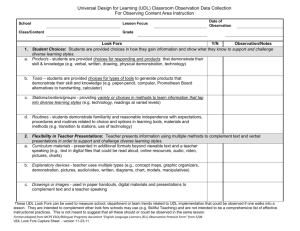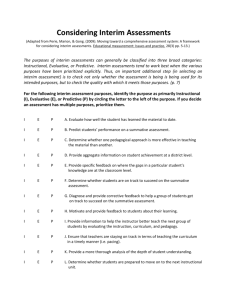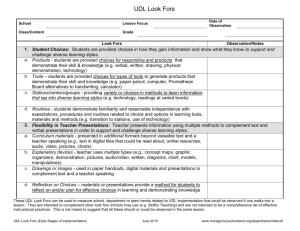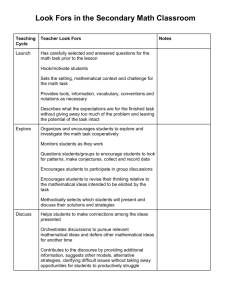Data-Driven Culture
advertisement
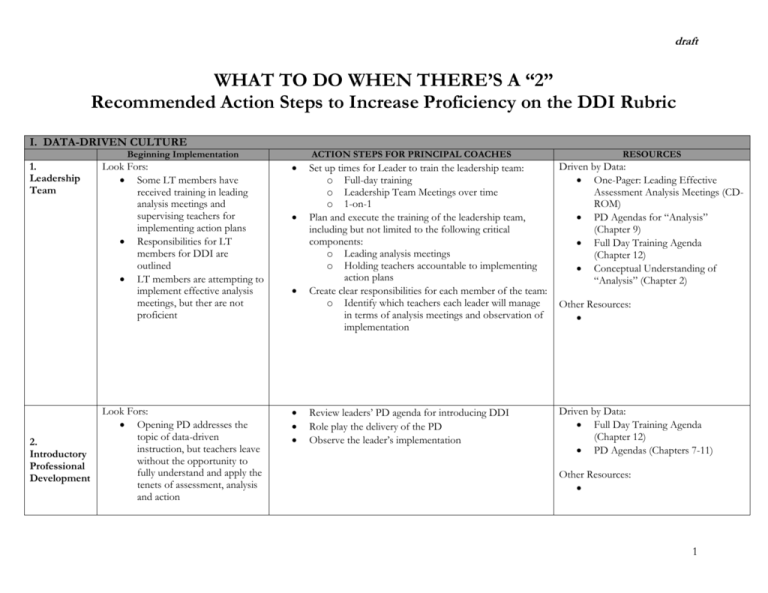
draft WHAT TO DO WHEN THERE’S A “2” Recommended Action Steps to Increase Proficiency on the DDI Rubric I. DATA-DRIVEN CULTURE Beginning Implementation 1. Leadership Team 2. Introductory Professional Development ACTION STEPS FOR PRINCIPAL COACHES Look Fors: Some LT members have received training in leading analysis meetings and supervising teachers for implementing action plans Responsibilities for LT members for DDI are outlined LT members are attempting to implement effective analysis meetings, but ther are not proficient Look Fors: Opening PD addresses the topic of data-driven instruction, but teachers leave without the opportunity to fully understand and apply the tenets of assessment, analysis and action RESOURCES Set up times for Leader to train the leadership team: o Full-day training o Leadership Team Meetings over time o 1-on-1 Plan and execute the training of the leadership team, including but not limited to the following critical components: o Leading analysis meetings o Holding teachers accountable to implementing action plans Create clear responsibilities for each member of the team: o Identify which teachers each leader will manage in terms of analysis meetings and observation of implementation Driven by Data: One-Pager: Leading Effective Assessment Analysis Meetings (CDROM) PD Agendas for “Analysis” (Chapter 9) Full Day Training Agenda (Chapter 12) Conceptual Understanding of “Analysis” (Chapter 2) Review leaders’ PD agenda for introducing DDI Role play the delivery of the PD Observe the leader’s implementation Driven by Data: Full Day Training Agenda (Chapter 12) PD Agendas (Chapters 7-11) Other Resources: Other Resources: 1 draft Beginning Implementation 3. Calendar 4. Ongoing Professional Development 5. Build By Borrowing Look Fors—Calendar includes: Some but not all of the items needed for proficient analysis & action Other Look Fors: Calendar is partially in place from the start of the year. Calendar is not very explicit within the culture of the school Look Fors: A couple of PD sessions are offered throughout the year that are aligned with the datadriven cycle PD is delivered with quality, but some participants may not have skills needed post-PD PD may lack sufficient modeling and application so that teachers have the skills needed to do analysis and action Look fors: Some leaders and teachers are borrowing ideas from their peers and from other schools, but that does not translate to schoolwide action Many teachers work in complete isolation ACTION STEPS FOR COACHES RESOURCES Build more complete assessment calendar with the Leader Generate strategies (if needed) to find extra paid-time for scoring and analysis Make a plan to disseminate the assessment calendar among all the staff in the school Driven by Data: Sample Assessment Calendars (CD-ROM) Evaluate with the Leader the core need areas of students and teachers after each round of interim assessments Design PD agendas to meet those needs Observe Leader facilitating the PD session Driven by Data: PD Agendas (Ch. 7-12) Identify high-achieving with the city and outside the city that would merit a visit o Work with Leader to schedule a visit to one of these schools o Debrief the visit with the Leader: what could you apply to your school? Identify ways to increase collaboration and sharing between high-achieving teachers within the school and the rest of their peers o Generate team meeting protocols to share best practices o Create formal mentoring roles Driven by Data: Success Stories (embedded throughout the book) Other Resources: Other Resources: Other Resources: 2 draft II. Assessments Beginning Implementation 1. Common Interim 2. Transparent Starting Point 3. Alignment State and College ACTION STEPS FOR COACHES Look Fors: Administered 2-3 times per year Common for grade and content area Only given in math and literacy at every grade level 311 Look fors: Teachers see assessments weeks before the administration or at a minimum, teachers are able to see the assessment before it is administered Look fors: Assessment items and tests match the state test level of rigor at least 50% of the time Alignment to college readiness is understood by leaders, but little action has occurred to make this alignment happen in the assessments RESOURCES Insert an additional interim assessment into the gap between two assessments that are too far apart MS/HS: Acquire Science/Social Studies interim assessments for implementation ES: Acquire K-2 Math & Early Literacy assessments Common for grade and content area Given in Math & Literacy at every grade level 3-11 Driven by Data: n/a Where transparency is not an option: o Find the best proxy for the interim assessment and have teachers review that proxy at the beginning of each IA cycle Work with Leader to build in time for teachers to review upcoming interim assessments Driven by Data: n/a Where this is possible, build a long-term plan to enhance the alignment and college readiness of the interim assessments o Identify the resources within you city: which Leaders schools have quality assessments/assessment supplements o Build a Spring/Summer design plan o Identify the resources to support the revision of the interim assessments Driven by Data: Assessment Alignment Spreadsheet (CD-ROM) Other Resources: Mark Murphy: 1-pager “State of Assessment” for each city STEP Assessments: K-2 Literacy Assessments (Univ. of Chicago) Other Resources: Mark Murphy: 1-pager “State of Assessment” for each city Other Resources: Mark Murphy: 1-pager “State of Assessment” for each city NLNS Interim Assessments in each city Note: This is not a quick hit. Only prioritize this when other areas are strongly in place. 3 draft 4. Aligned to Instructional Sequence 5. Reassess Look fors: Grade level or content area has a clearly defined scope and sequence of standards, but assessments only partially match that the scope and sequence. What is taught is assessed Look fors: Assessments sporadically reassess standards throughout the year Build a long-term plan to improve the alignment between the teaching scope & sequence the interim assessments o Identify the resources within you city: which Leaders schools have quality alignment o Build a Spring/Summer design plan o Identify the resources to support the revision of the scope & sequence Note: This is not a quick hit. Only prioritize this when other areas are strongly in place. See above: same next steps Note: This is not a quick hit. Only prioritize this when other areas are strongly in place. Driven by Data: n/a Other Resources: Mark Murphy: 1-pager “State of Assessment” for each city NLNS Scope & Sequences in other schools in the city Driven by Data: Assessment Alignment Spreadsheet (CD-ROM) Other Resources: Mark Murphy: 1-pager “State of Assessment” for each city NLNS Interim Assessments in each city III. Analysis Beginning Implementation 1. Results Turnaround 2. Data Reports ACTION STEPS FOR COACHES Look fors: Results available within a week Teachers not involved, or minimally involved in scoring Look fors: Reports either have too little or too much information Reports might not include item analysis or overall results Reports are understandable for leaders but require some interpretation for teachers RESOURCES Evaluate the process of scoring turnaround: where can the scoring be accomplished more quickly? ID necessary supports/resources to quicken the scoring Driven by Data: Sample Results Turnaround Schedule (Ch. 2, Analysis) Utilize an existing template in your city to design a more concise analysis report/spreadsheet for teacher analysis Create a calendar for implementation of the better data report Other Resources: Driven by Data: Sample Data Report/Analysis Spreadsheet (CD-ROM) Other Resources: Mark Murphy 1-page “State of Assessment” 4 draft 3. Teacher Owned 4. Test in Hand 5. Deep Analysis Look fors: Teachers do little of the analysis; analysis mostly done by principal, instructional leader or a “data team” Teachers may lack knowledge and skill to effectively and efficiently analyze results Teachers analyze, but may blame test or students for poor results Look fors: Teachers or leaders have the assessments in hand during analysis, but not both Teachers look mostly at the assessment questions, and do not focus strongly on the student responses Deep analysis: mostly answers what students got wrong; infrequently answers why they got it wrong Look fors: Teachers reach actionable conclusions with analysis, but often conclusions are general and not fully based on a deep understanding of results Analysis includes some generalizations like “students need to read more” or “students need to practice problem-solving” Watch video of effective leader facilitation of assessment analysis meetings that get teacher to own the analysis Observe Leader leading analysis meetings: debrief and meeting and discuss techniques to improve implementation Review Leader’s plan to lead assessment analysis meetings: ensure that the test will be used during the analysis meeting Observe assessment analysis meetings Watch video of effective leader facilitation of assessment analysis meetings that have deep analysis Observe Leader leading analysis meetings: debrief and meeting and discuss techniques to improve implementation Driven by Data: One-Pager: Leading Effective Assessment Analysis Meetings (CD-ROM) PD Agendas for “Analysis” (Chapter 9) Conceptual Understanding of “Analysis” (Chapter 2) Other Resources: Driven by Data: n/a Other Resources: Driven by Data: One-Pager: Leading Effective Assessment Analysis Meetings (CD-ROM) Conceptual Understanding of “Analysis” (Chapter 2) Other Resources: 5 draft IV. Action Beginning Implementation 1. Lesson Planning 2. Teacher Action Plans 3. Ongoing Assessment ACTION STEPS FOR COACHES Look fors: Teacher teams problem solve and plan together based on data, but often not focused on specific student needs or don’t have specific lesson plans as a result Planning conversations often focus on teaching it again, and less on how to teach it differently Look fors: Teachers plan for reteaching, but often planning is not specific regarding goals, time, and strategy Differentiation is present in planning, but often only superficial Look fors: Teachers assess at least weekly based on previous data and standards currently being taught Teachers link weekly assessment to reteaching, but often fail to act based on reassessment results Ongoing assessment efforts rarely take into account the different levels of proficiency present in the class RESOURCES Do a review of teacher lesson plans with Leader: is there evidence of re-teaching or targeted teaching of key standards on the interim assessments? Plan with Leader the support for teachers who are struggling to implement new teaching strategies for reteaching difficult standards Driven by Data: n/a Do a review of teacher action plans with Leader: where are they lacking? Plan out the work with each teacher to improve their action plans Driven by Data: Teacher Action Plan Template (CD-ROM) Data-Driven Classroom Best Practices for Rigor (Appendix & CD-ROM) Schedule periodic building walkthrough with Leader o Is there evidence of checking for understanding in the classes (questioning, do now review, exit tickets, etc.)? o Do a spot check of teacher quizzes/tests: are they aligned to or exceed the rigor of the interim assessments? Plan out the work of the Leader with the teachers who need the most support in this area Other Resources: Other Resources: Driven by Data: Data-Driven Classroom Best Practices for Rigor (Appendix & CD-ROM) Other Resources: 6 draft Beginning Implementation 4. Accountability 5. Engaged Students ACTION STEPS FOR COACHES Look fors: Leaders are aware of action plans but don’t have much personal knowledge of their content Leader is only periodically observing for reteaching and rarely focused on specific reteaching efforts Leaders follow up with teachers after observing, but often this follow up is not specifically linked to the data and instructional practice Follow up by leader often lacks clear, actionable changes sought to classroom instruction Look fors: Students are aware of their performance on the assessments Students can articulate why the interim assessments are important Students know they are working during class time to develop mastery toward standards RESOURCES Driven by Data: Data-Driven Classroom Best Practices for Rigor (Appendix & CD-ROM) In check-ins, ask Leader for specific updates on the action plan implementation of his/her teachers. Ask him/her to show you some of those action plans and evidence of his/her observations o If Leader is not aware of the action plans, set up concrete dates for observation & follow-up Other Resources: o Create a binder with the Leader to keep a copy of Observation Tracker (check in the teacher action plans in his/her office with Paul) Schedule periodic building walkthrough with Leader o Is there evidence of checking for understanding in the classes (questioning, do now review, exit tickets, etc.)? o Do a spot check of teacher quizzes/tests: are they aligned to or exceed the rigor of the interim assessments? Create an observation tracker for the Leader to track his follow-up observations; review the tracker at your regular check-ins Generate a calendar of action steps that will get students more involved in their analysis Help Leader acquire a student engagement reflection sheet and adjust to his/her needs Do a spot check with students during school visits; share with the Leader whether they know/don’t know about their assessment results Driven by Data: Student Engagement Reflection Template (Appendix & CD-ROM) Other Resources: Student Engagement templates from other Leaders in your city 7

